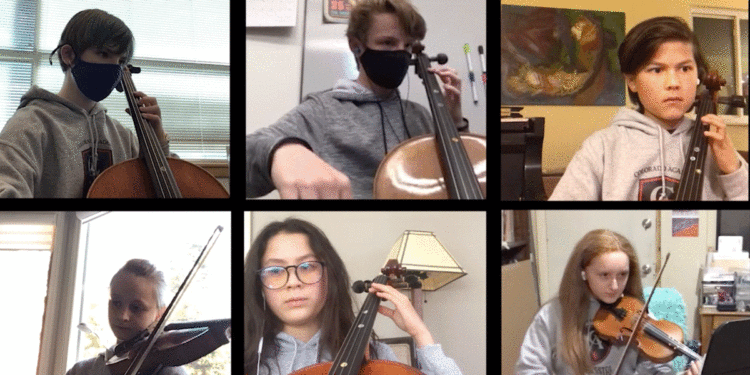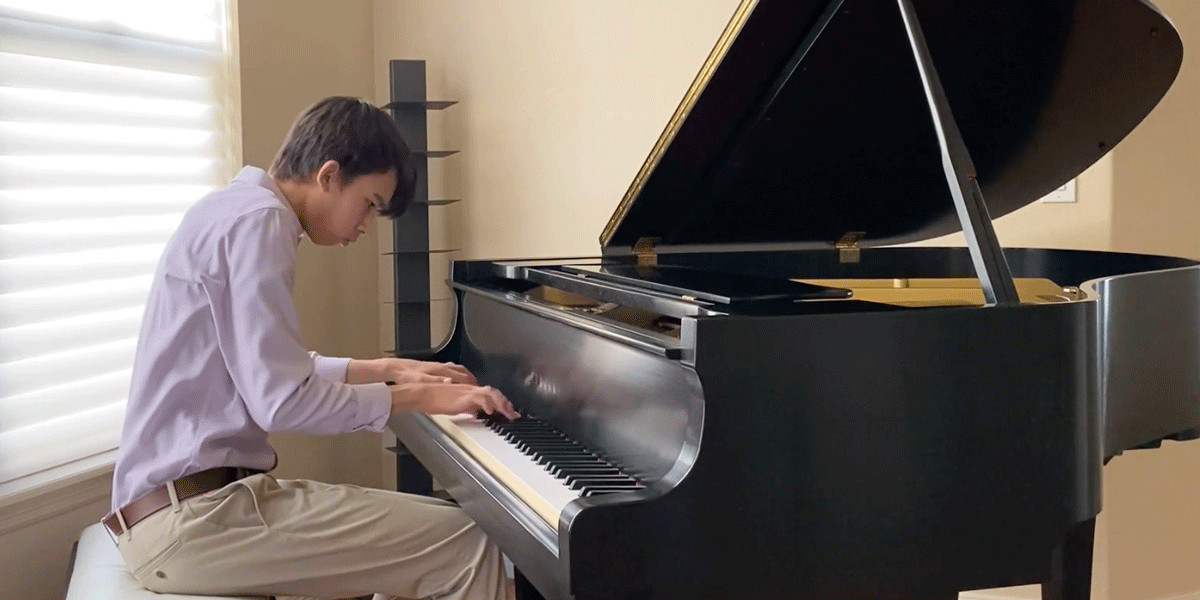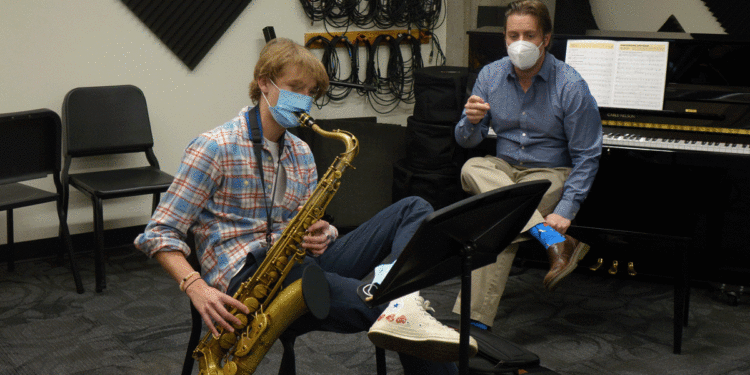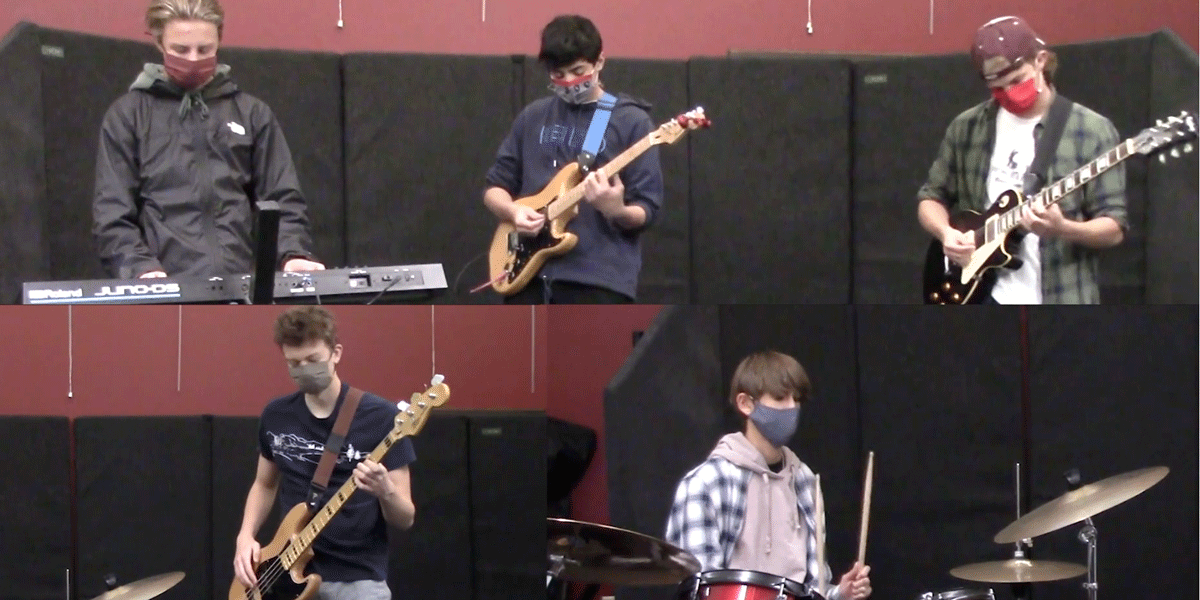As Chair of the Colorado Academy Music Department, Phil Jones is not given to dramatic pronouncements or hyperbole. His description of what his department has faced since the onset of the COVID-19 pandemic in spring 2020 reflects his straightforward manner. “It was key that CA got us all set up on Zoom so quickly,” he says. “But Zoom does not really work for playing music together.”
If you talk to Sawyer Pinkowitz, who is a drummer in Academy Jazz, about how things have gone for Colorado Academy musicians this past year, he can offer a student’s viewpoint. “The music program this year has gone beyond what I expected during COVID,” the Junior says. “It’s been an absolute victory.”
Pinkowitz’s experience is a tribute to the hard work of Jones and all the instrumental teachers who have pivoted and remained flexible to keep their program flourishing, despite the restrictions of a pandemic.
Implementing new rules

In spring 2020, when CA went to fully remote learning, Jones changed his curriculum to move students away from performance toward music composition and a little bit of music theory. When the 2020-2021 school year began, it was apparent that Zoom was here to stay, at least for much of another school year. “I needed to find a way to enable students to play music and play together as safely as possible,” Jones says.
He started by researching best practices through the National Federation of State High School Associations. Then, he implemented their recommendations:
- Students should play instruments outside as much as possible.
- Instruments like the saxophone and trumpet would need bell covers to mitigate the spread of aerosol droplets.
- Students would need to remain masked while playing an instrument, even if that meant cutting a hole in the mask.
- Flutists could play by moving the head joint of their instruments inside their masks.
- Teachers would also need to be masked and remain at least six feet away from students.
- Shared instruments, like pianos, would have to be frequently cleaned with a gentle disinfectant that wouldn’t cause damage.
As a drummer, Pinkowitz had a fairly simple approach to COVID restrictions: “I bring my own sticks and I never take my mask off.”

Finding a way to perform
One significant change during COVID-19 was the cancellation of all public performances. Undaunted, Jones figured out various alternatives for the Jazz and Rock Combo, Upper School Orchestra, and the Middle School Orchestra.
“We used recordings as replacement for performances,” he says. “It gave students the experience of playing together even though they were not in the same room.”
Working around the CA Flex schedule, when only half a group would be present in class at any time, Jones recorded small groups of musicians, and then edited audio and video tracks together to create a semblance of a live performance. It was a work-around that proved to be more positive than he had expected.
“In a live performance, it’s impermanent, and it’s over in a moment,” he says. “But in a recording, you can repeat until you get the best take and then use that version for the performance. The students really got involved in that process, because they discovered that learning goes on when you listen to yourself.”

Some students performed a virtual recital. Instead of gathering at school for a live audience, they recorded themselves at home and submitted their performances. Watch 10 of CA’s students performers at their social distant Winter Recital.

Saving students’ social and emotional health
Pinkowitz, who remembers the first time Jones brought him into the music studio when he was in Lower School and “really boosted my Fifth Grade ego,” believes that Jones has made the best of a difficult situation.
“He is a wizard with his computer and the way he can put all our performances together,” Pinkowitz says. “And even if we can’t play together, he has done a good job of bringing us together to listen to and talk about music.”
Being able to continue instrumental music during the disruption and stresses of a pandemic has also had an impact on the social and emotional health of students.
“Playing music has been so beneficial to me,” Pinkowitz says. “It’s a break from the rigor of school and a time with a teacher who understands you and makes you feel good.”
And the increased recording of music during the pandemic—whether in groups or during virtual recitals—has proven to provide an unexpected silver lining with advantages for some students.
“Some students stop studying music, because they don’t enjoy the pressures of live performance,” Jones says. “With virtual recitals and the chance to record more than one performance, students face their fear of performing, and they get over it.”
